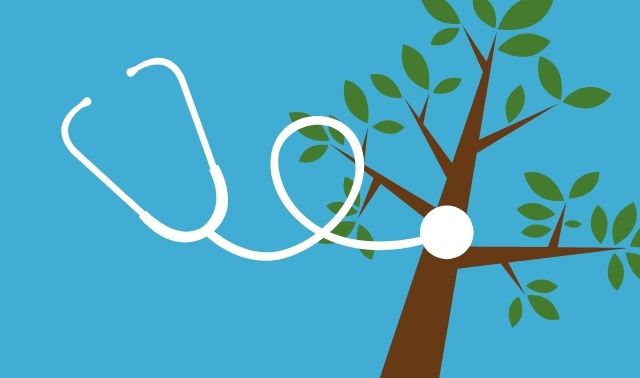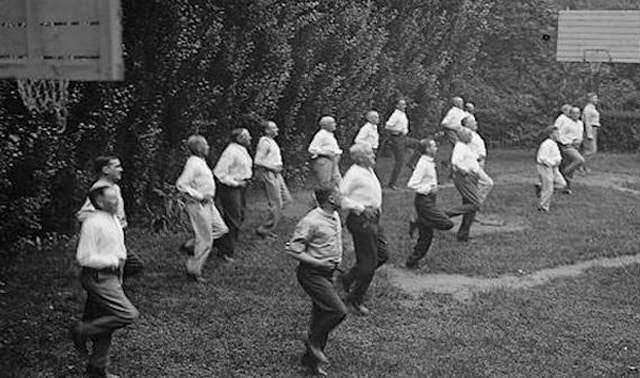I’m a family tree doctor. Some might call me an editor or a proofreader of genealogies, but what I’m actually doing is diagnosing diseased family trees.
Here are some of the “ills” I’ve seen:
- A woman in her 70s having babies
- A man getting married at age 9
- Twins born in different counties
- A baby who came into the world 10 years after his mother died
- Siblings who were born only three months apart
- One man married to two (or more) women at the same time (Well, OK. Sometimes that really does happen.)
As a tree doctor, my job is to ensure that these diseased genealogies get the proper treatment so family historians can learn the truth about their ancestors—and so the infections don’t spread to other researchers’ trees.
But it’s not just genealogical trunks, branches and leaves that harbor diseases. The roots of our research—the records we use as sources—also might contain ailments.
Not to worry: The cure isn’t complicated. All it takes to thwart the spread of common maladies into your family tree is an ounce of prevention. By learning how to spot nine sicknesses in genealogical resources, you can avoid contaminating your family tree. Consider this your bulletin from the Genealogical Centers for Disease Control.
1. “Inaccurate Index Infection”: Overcoming Indexing Errors or Missing Ancestors
Signs: You just know your ancestor should be named in a particular record set. Maybe you even think you’ve found him before in an online index to those records. But for the life of you, you can’t find him in the index now. What’s the deal?
The database you’re searching might be suffering from “inaccurate index infection.” Online indexes make searching quicker than in the olden days of scrolling microfilm, but we also love to hate them. Find your ancestor on the first try, and you’re happy. By the third, fourth or 20th try, your enthusiasm wanes. Why is this so hard? you wonder.
You might have several things working against you. Humans created the indexes, and we all know humans aren’t perfect. We’re prone to making typos, misreading unfamiliar names and handwriting, and transposing letters unintentionally. Some indexes on large subscription websites are created abroad by trained but nonnative English speakers. Or you might be searching an index generated by optical character recognition software, in which a computer “reads” digitized records and turns the words into a text file. Combine any of these factors with the county clerk’s or census taker’s errors on the original, or a fuzzy scan, and the potential for indexing problems is compounded.
Treatment: Get creative with your searches. Say you’re looking for an ancestor in a census database. If his name isn’t coming up, use wildcard searches to catch odd variant spellings. Try just the surname and place, in case the first name is abbreviated or misspelled. Take the name out altogether and search on other factors, such as country of birth and immigration year. Try another family member’s name. Still no luck? Check the street section of a city directory to see who the neighbors are, and search for them.
If all else fails, you might have to browse the actual records page by page. Keep in mind, too, that websites periodically change search algorithms in an effort to improve your search results—so keep trying. When you do find an index entry for your ancestor, always seek the original record and ask yourself whether the information in it makes sense given what you’ve discovered about your family. This disease also speaks to the importance of accurately recording your online searches. Keeping track of databases you search and the search terms you enter will make it easier to find the person again.
2. “Death Certificate Deficiency”: Finding More Details about Deaths
Signs: Even though death certificates are what many genealogists call a primary source—that is, a record created at the time of the event—the information on the certificate contains both firsthand and secondhand evidence. Interpret the information incorrectly, and an infection in the record could lead to disease in your family tree.
The firsthand evidence is the information the physician or his attendant provided on the cause of death, the date and contributing factors. Understand, however, that even this information can be in error. The cause of death could be obscured or misstated to protect a person’s reputation and privacy: Instead of “suicide,” for example, the cause of death might be described as “accidental.” Physicians can misdiagnose the cause of death, especially when no autopsy is performed.
Given our ancestors’ medical knowledge, the cause of death could be erroneous based on what we know about diseases today. A diagnosis back then wasn’t supported by sophisticated tests such as X-rays, blood analysis or microscopic tissue examinations. It was based on signs and symptoms only, and many diseases have similar symptoms. It can be difficult, if not impossible, to determine a modern equivalent to a 19th-century cause of death.
Secondhand information on a death certificate concerns factors not related to the death. An informant—perhaps a child, sibling or neighbor—provided details about the deceased, such as date and place of birth, age, parents’ names and birthplaces. The informant could know only what the deceased or other family members told her, so you can’t be certain of the accuracy of this information. Also keep in mind that grief may have clouded the informant’s thinking. Informants have been known to accidentally give their own mothers’ maiden names, for example, instead of the deceased’s.
Treatment: Analyze each piece of information on a death certificate, determining whether it’s firsthand or secondhand evidence. Though you might not be able to corroborate the cause of death, you can verify much of the secondhand evidence by searching other records: cemetery, obituary, funeral home, birth, baptismal and military records, and so forth.
3. “Census Inconsistency Syndrome”: Resolving Conflicting Data in Censuses
Signs: Federal census records are the backbone of genealogical research, giving you a snapshot of families at 10-year intervals. Say you found your ancestor in each surviving census from 1850 through 1900. Does all the information from one census to another match?
If so, you’ve got a rare situation. Most of us find slight to significant discrepancies from one census to another, which can wilt a family tree. One census says the birthplace was New Jersey. Another says New York. One record’s got the ancestor’s name as William. Another gives it as John. According to one census, Great-uncle Joe immigrated in 1894. According to another, the year was 1897. Great-grandma’s age is 52 in one census; 10 years later she’s 58.
How does this happen? For one thing, census records don’t give you the name of the informant. It could be the husband one census, the wife the next, and a neighbor after that. And personal information that’s important to our identities, such as age and birthplace, generally wasn’t as meaningful to our ancestors. They might go by different nicknames at different times in their lives, or use various name spellings. As time passed, people could forget exactly when they immigrated or where the oldest child was born.
Treatment: As a general guideline, you can consider census information recorded closest to the time of the event as most trustworthy. For example, if three different censuses say Great-grandpa came to the United States in 1881, 1880 and 1882, generally, the earliest census that records the immigration information is likeliest to be accurate.
If Susie is age 2, 11 and 19 on three consecutive censuses, you have to look at two things. First, the census closest to the original event, her birth, is mostly likely correct. Second, check the official census day for that census. The census taker was supposed to record people based on that day. For example, the census day for 1900 was June 1, for 1910 it was April 15, and for 1920, it was Jan. 1. So an ancestor whose birthday is, say, May 10, 1885, should be 15 in the 1900 census, 24 in 1910, and 34 in 1920.
4. “Immigration Mythopia”: Busting Immigration Myths
Signs: Has a story about a stowaway ancestor blossomed in your family? Stowaway stories are more romantic and adventuresome than buying a ticket in steerage. Interestingly, stowaways are almost always men. You rarely hear about Great-grandma being a stowaway. These family stories may be suffering from a serious disorder that can result in decay of the fruit on your tree.
While some people actually did sneak aboard ships, it wasn’t a common practice, so you should still look for your ancestor on passenger lists. If a stowaway was discovered en route, he should be recorded on the last page of the list.
Along with stowaways, another story seems to blossom in families like dandelions in the spring. Not long ago, I saw someone post on Facebook that Ellis Island officials changed immigrants’ names. I thought this myth had been eradicated a long time ago, but some beloved myths continue to spread no matter how you treat them.
No evidence whatsoever exists to suggest that names were changed on Ellis Island. During its operation as an immigrant receiving station from 1892 to 1954, Ellis Island was staffed with hundreds of interpreters who collectively spoke more than 30 languages. Inspectors asked immigrants their names, and then compared them what was recorded on the passenger lists. These lists were created at the ports of departure as passengers bought their tickets.
Inspectors were told not to change anything on the list unless there was an error, and there was no reason to change anyone’s surname. These pervasive family stories likely arose because immigrants changed their own names after they settled in America to avoid prejudice and blend in more easily. Another typical time for first and sometimes last names to be changed was when immigrant children entered school—American teachers sometimes couldn’t pronounce foreign names. They might call Francesco “Frank” and write the Polish surname Adamczyk as “Adams.” See Immigration Daily for more on family name changes and Ellis Island immigration procedures.
Treatment: If one of these myths exists in your family, it might be hard to convince some relatives it might not be true. That’s OK. Some stories will live on no matter what you do. What’s important is that you record what you believe is true, based on solid genealogical and social history research, in your genealogical files and in what you share and publish.
5. “Bungled Birthdate Disorder”: Correcting Impossible Vital Information
Signs: Sometimes the disease you’re battling is information that doesn’t make chronological sense—for example, a baptism that predates the birth. Although some religions practiced adult baptism, baptism in utero is extremely rare. Your ancestor might appear to have been baptized before birth for a couple of reasons. The family might have been waiting for a circuit-riding minister to arrive to perform the baptism, and it’s possible he accidentally reversed the birth and baptism dates in his records.
A more likely scenario in this case is that the parents fudged the birth date on a civil birth record. If there was a late fee to register the birth after a certain amount of time had passed, parents might record the child younger than he was to avoid paying the fee. In fact, they might make him so young that he was baptized before he was born.
Treatment: Double-check the records where you found the information, and keep seeking other sources to help you clear up when the events you’re researching actually occurred. In your genealogical records, mark a date with a [sic] to indicate you know there’s a logic or chronology problem. Explain in your notes that the dates are recorded exactly as they were in the documents, and if you have a theory about what actually happened (for instance, that a minister reversed the dates), include it as well.
6. “Sloppily Sourced Pedigree Virus”: Identifying Poor Source Citations
Signs: Maybe someone wrote a family history about your ancestors, or you find a tree online that takes your genealogy back several generations. These are gems—an accurate and documented online tree or published family history can save you countless hours of research. On the other hand, it could create countless hours of research if you discover that the genealogy is diseased and wasn’t well-researched. The leaves on these trees can have some dead tissue.
Treatment: If you find a copy of a published family history, evaluate whether its information is reliable by looking at the source citations and attached documentation. If sources are cited, do a little fact-checking. Can you find some of the documents the author mentions? After looking at them, do you agree with the author’s interpretation?
It’s common to find undocumented family trees online, and they may be diseased. Often, casual tree tracers regurgitate what they find in still other online trees, and it’s impossible to tell where the information came from. To prevent the spread of sloppy sourcing into your tree, use these other trees as clues only. Verify in original sources everything you find.
Before making details from a published genealogy a permanent part of your tree, look for book reviews of published genealogies in current and back issues of respected genealogical journals. Try American Genealogist and the National Genealogical Society Quarterly, as well as locality-specific newsletters and journals such as The New York Researcher and The New England Historical and Genealogical Register. Reviews usually appear within a year or two of a book’s publication and give insights into the work’s strengths and weaknesses.
Also check online to make sure you haven’t come across a family history once accepted as fact but now known to contain misinformation, such as many works by turn-of-the-20th-century genealogist Gustave Anjou.
7. “Family Fable Flu” Fact-Checking Family Stories
Signs: Do your relatives speak fondly and confidently of being American Indian—perhaps even descended from a Cherokee princess? (Why is it no one is ever descended from a Lumbee princess?) Like the story of an Ellis Island name change, this is one of those classic legends handed down in families. Such stories can leave a powdery mildew coating on your family tree, disfiguring new shoots. Maybe your family has a “three brothers” story: Three brothers immigrated to America (never two or five, and never a sister). Once they got to America, one went north, one south, and the other west, never to be heard from again.
Or perhaps Great-grandpa always said you have royal or noble ancestors, people who were entitled to display a coat of arms. But in reality, a good percentage of the people who departed their native land for America weren’t entitled to inherit anything—land, a title or heraldic arms. That’s why they left. Why would a duke or a prince give up his inheritance and leave for the uncharted frontier of America?
Treatment: If you have an American Indian tale in your family, investigate and establish whether or not a tradition of Indian ancestry is true. As with most family lore, there’s usually a grain of truth couched somewhere in the story. What, specifically, led family members to accept the tale? The places where the ancestors lived? High cheekbones in a family photo? Grandma’s word? Get all the details you can from family, then start your hunt in records.
Be wary of the three brothers myth. Families often did emigrate together—as well as with friends and neighbors—but three men on a ship with the same last name aren’t necessarily brothers. Your clan’s immigrant group could’ve included parents, children, aunts, uncles and cousins, all on the same voyage or in a “chain” over years.
Although not a hard-and-fast rule for every country, generally the second or later sons would emigrate because of the custom known as primogeniture—this dictated that the eldest son would inherit their father’s property. And even though many Americans can trace their ancestry to kings and queens, don’t automatically trust the family tradition. Check it out for yourself through research. Sometimes folks discover they’re really linked to the illegitimate children of the kings and queens—which in itself holds a special status.
As for coats of arms, keep in mind they’re granted to a person, not to a family, and typically pass from eldest son to eldest son. Younger sons and even daughters may use the main design, with alterations to denote a son or daughter and birth order. But what about that illustrated coat of arms that Uncle Harold found online and now displays with pride as the Schwartzfedder “family crest”? It may have nothing to do with your ancestors.
8. “Newspaper Necrosis”: Seeing Through Inaccurate Reporting in Historical Papers
Signs: Newspapers can be another cause of spotty infections on your tree. Like death certificates, they might have a mix of firsthand and secondhand evidence. Informants for articles might be full of wrong details. The same goes for that genealogical standby, the obituary. If you took obituaries at face value, you’d think that lazy, worthless individuals rarely die. Almost everyone who dies is an “upstanding citizen, faithful to God, and an all-around-good person.” Reading some early 19th-century obituaries, you might even think the deceased would qualify for sainthood.
Some papers loved to sensationalize stories, especially in the 1800s. When you think about it, this medium was the primary entertainment for most people back then. Just like today’s media audience, our ancestors enjoyed scandals and murders. In cities with more than one paper, competition for readers was fierce. Some newspapers prided themselves on reporting facts accurately, but others strove to appeal to readers who enjoyed a good story—the more lurid and melodramatic, the better.
Treatment: Always confirm the information you find in a newspaper article and compare it to other records before accepting it as fact. And take those glowing obituaries with a grain of salt. Documents such as court cases, military service records and divorce petitions might tell a different story.
9. “Will Lingoitis”: Finding and Understanding Wills
Signs: Genealogists love finding ancestors’ wills because they often state family relationships. The testator, or person making the will, is like an enormous single cell with thousands of nuclei just waiting to grab his worldly belongings. But if you’re not careful when interpreting the terminology in the will, you might find your tree contaminated with wrong relationships.
Men would often leave items to a “beloved wife” (I’ve yet to see one say, “to my nagging wife”), without mentioning her name. Why should he? Everyone knew who she was. But sometimes a husband’s will named his wife and even gave her maiden name. Consider yourself lucky if you find one like this. Or the man might call her “my now wife.” This simply referred to his wife when he made out the will; it’s not necessarily an indication he’d been married before.
You might find a will that makes no mention of a child you know existed. Such omissions can be a result of a prior transfer of property to the child (often when the child married), the death of a child before the will was made, a child born after the will’s author died, or the disowning of a family member. If the last is the case, this omission should be stated so that the disinherited offspring can’t later contest the will.
Then there are those other relationship terms, such as nephew. In wills of the 1700s in particular, this term could mean a grandson or granddaughter. The word nephew derives from the Latin, nepos, which meant grandson. Similarly, brother might mean a blood brother, or it could mean a half-brother, a stepbrother, a brother-in-law or a brother in the church. The same with sister.
Treatment: To understand legal terminology in wills, deeds and other court records, consult Black’s Law Dictionary. You can find in the reference section of most large libraries.
You can’t view any genealogical record in isolation: Each one is only a piece of the puzzle. On their own, the pieces don’t amount to much. But when you put them all together, what have you got? A stunning family tree, one that’s disease-free and in full bloom.
A version of this article appeared in the October/November 2012 issue of Family Tree Magazine.










